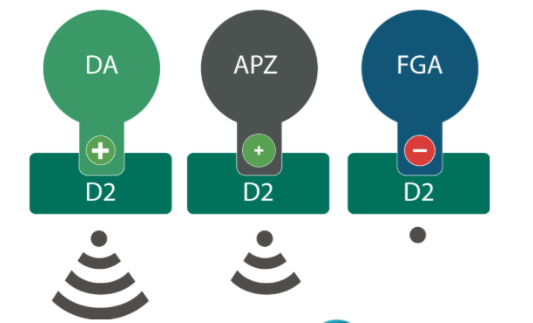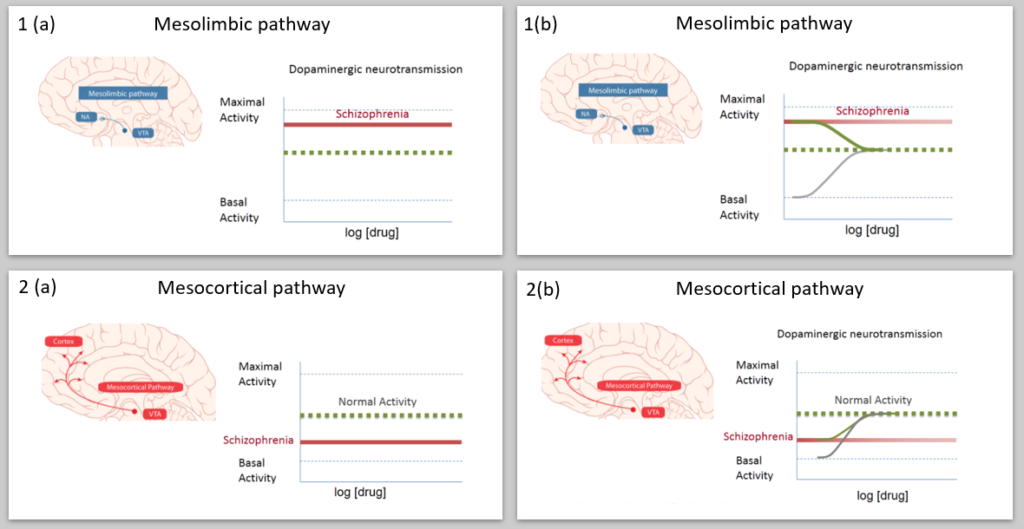
- Aripiprazole is a 2nd generation antipsychotic which was approved by FDA in 2002 for treatment of schizophrenia. Some researchers also consider aripiprazole as 3rd generation antipsychotic.
- It is preferred compared to 1st generation antipsychotic due to its improved side effect profile. It is also available as generic medicine.
Indications of aripiprazole
- In schizophrenia.
- In bipolar I disorder (as maintenance therapy for mania and mixed episodes)
- Used in Tourette syndrome.
- Irritation caused by autistic disorder.
- As adjunctive treatment for major depressive disorder.
Mechanism of action of aripiprazole

Figure 1- Aripiprazole is partial D2 receptor agonist (Source- Psychopharmacology institute)

Figure- Mechanism of action of aripiprazole (1a- Mesolimbic pathway in schizophrenic patient, 1b- Mesolimbic pathway after aripiprazole administration, 2a- Mesocortical pathway in schizophrenic patient, 2b- Mesocortical pathway after aripiprazole administration)
Source- Mailman et al, 2020.
- It is a partial dopamine (D2) agonist which binds to D2 receptor with same affinity as dopamine. It has lower intrinsic efficacy which makes its response lower than dopamine and higher than that of dopamine antagonist (for examples- haloperidol, clozapine, risperidone etc.).
- As per dopamine theory of schizophrenia, overactivity of dopamine in mesolimbic pathway produces positive effects like hallucination, delusion etc. Negative (lack of interest, lack of social interaction) and cognitive (thought disorder, bizarre behavior) symptoms are caused by hypofunction of dopamine in mesocortical pathway. Aripriprazole reduces dopaminergic activity in mesolimbic pathway by partial D2 agonism and reduce positive symptoms. Its ability to alleviate negative and cognitive symptoms is believed to be its ability to increase dopaminergic activity from subnormal to normal in mesocortical pathway.
- It is also partial 5HT1A agonist and 5HT2A antagonist. Also stabilizes serotonin within nucleus accumbens, ventral tegmental area (VTA) and frontal cortex. It has moderate affinity for D4, H1, 5HT-2c and alpha-1 adrenergic receptors.
Pharmacokinetics of aripiprazole
- Administered as oral formulation (tablet, orally disintegrating tablet and oral solution). IM injection is also available. Long acting IM injections are available in formulation300 mg or 400 mg prefilled syringes and are administered once in a month. These injections are mostly used in patient with poor medication tolerance. It is administered with or without food.
- Plasma protein binding is high (around 99%). It primarily binds with albumin. Peak plasma concentration is observed within 3-5 hours.
- Half-life of oral administration is around 75 hours. Metabolism takes place by hepatic dehydrogenation, hydroxylation and N-dealkylation via CYP2D6 and CYP3A4. CYP2D6 catalyze dehydrogenation and hydroxylation and CYP3A4 catalyze N-dealkylation.
Advantages of using aripiprazole over other antipsychotics
- Motor symptoms like acute dystonia, tardive dyskinesia, akathisia and parkinsonism are major side effects of 1st generation antipsychotics. Other 2nd generation antipsychotics mostly cause weight gain and metabolic side effects like deterioration of type 2 diabetes.
- Due to its partial D2 receptor agonism, aripriprazole has decreased motor and metabolic side effects. Hence, it is a valid alternative for patients who are struggling with low efficacy or severe and persistent side effects of current antipsychotic treatment.
Adverse effects
- Less degree of extrapyramidal (motor) symptoms (EPS) and metabolic side effects. EPS can be managed with sodium benzoate or benztropine.
- Hyperprolactinemia caused by aripriprazole may lead to gynecomastia in male, amenorrhea, off-cycle bleeding and galactorrhea in female and sexual dysfunction. Other related side effects are nausea, vomiting, light headedness, somnolence etc. It is also associated with development of uncontrollable urge to have sex, binge eat, shopping and gambling.
- Some rare side effects include agranulocytosis, seizures, neuroleptic malignant syndrome and liver abnormalities.
- It has FDA black box warning for increased risk of cerebrovascular events ad death in elder patients with psychosis and suicidal thoughts in children and adolescents.
- Patients should be closely monitored for any side effects.
Drug Interaction
- Drugs which induce CYP3A4 like carbamazepine may increase its clearance and decrease its plasma concentration on concurrent administration. CYP3A4 inhibitors like ketoconazole or CYP2D6 inhibitors like quinidine, fluoxetine may inhibit metabolism of aripriprazole and increase its plasma concentration. Dose adjustment is needed when co-administered with such drugs.
Contraindication
- Contraindicated in patients with known hypersensitivity to aripiprazole.
References
- https://www.ncbi.nlm.nih.gov/books/NBK547739/
- Sciascio GD, Riva MA. Aripiprazole: from pharmacological profile to clinical use. Neuropsychiatr Dis Treat. 2015; 11: 2635–2647.